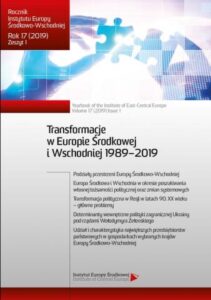ORCID: Tomasz Białowąs: 0000-0002-8898-9989
Strony: 265-279
Wydanie: Lublin 2019
DOI: https://doi.org/10.36874/RIESW.2019.1.12
Sposób cytowania: T. Białowąs, Znaczenie korporacji międzynarodowych w eksporcie towarowym Polski na tle państw Europy Środkowej w latach 2004-2018, „Rocznik Instytutu Europy Środkowo-Wschodniej” 17 (2019), z. 1, s. 265-279, DOI: 10.36874/RIESW.2019.1.12.
Słowa kluczowe: Central European countries, foreign trade, structural change
Keywords: Central European countries, foreign trade, structural change
Abstrakt:
The subject of the article is the assessment of the impact of international corporations’ activities on the development of Polish commodity exports against the background of Central European countries in 2004–2018. The detailed analysis covers changes in the value, dynamics, product and geographical structure of exports, the importance of foreign subsidiaries of international corporations in creating export potential and the share of foreign value added in gross exports. The conducted analysis showed a high degree of dependence of Polish exports, as well as those of the Czech Republic, Hungary and Slovakia on the operations of foreign subsidiaries of international corporations. Their share in the total exports exceeded 50% during the analyzed period, and 85% in the exports of cars and trucks, pharmaceuticals, tobacco products, computers, electronic and optical devices. An important factor in the development of exports is the phenomenon of international fragmentation of production processes. It causes an increase in trade turnover in subassemblies and intermediate goods. We can estimate the scale of production fragmentation by measuring the share of foreign value added in gross exports. The highest share of foreign value added occurred in the exports of Hungary and Slovakia and exceeded 40%. In Poland, foreign value added accounted for around 27% of gross exports. In all analyzed countries, foreign value added came mainly from the European Union countries, especially from Germany. In recent years, the share of intermediate goods imported from China has also been growing.
Bibliografia:
Asmundson I., Dorsey T., Khachatryan A., Niculcea I., Saito M., Trade Finance in the 2008–2009 Financial Crisis: Evidence from IMF and BAFT-IFSA Surveys of Banks, [w:] J.-P. Chauffour, M. Malouche (eds), Trade Finance During the Great Trade Collapse, The World Bank, Washington, D.C. 2011.
Baldwin R., Global Supply Chains: Why They Emerged, Why They Matter, and Why They Are Going, [w:] D. Elms, P. Low (eds), Global Value Chains in a Changing World, WTO, Geneva 2013.
Bems R., Johnson R. C., Yi K.-M., The Great Trade Collapse, „Annual Review of Economics” 2013, vol. 5, no. 1.
Constantinescu C., Matto A., Ruta M., The Global Trade Slowdown: Cyclical or Structural?, „IMF Working Paper” 2015, no. 15/06.
Eurostat, https://ec.europa.eu/eurostat [10.07.2019].
GUS, Działalność gospodarcza podmiotów z kapitałem zagranicznym w 2012 r., Warszawa 2013.
GUS, Działalność gospodarcza podmiotów z kapitałem zagranicznym w 2013 r., Warszawa 2014.
GUS, Działalność gospodarcza podmiotów z kapitałem zagranicznym w 2014 r., Warszawa 2015.
GUS, Działalność gospodarcza podmiotów z kapitałem zagranicznym w 2015 r., Warszawa 2016.
GUS, Działalność gospodarcza podmiotów z kapitałem zagranicznym w 2016 r., Warszawa 2017.
GUS, Działalność gospodarcza podmiotów z kapitałem zagranicznym w 2017 r., Warszawa 2018.
GUS, Rocznik statystyczny handlu zagranicznego 2018.
Helpman E., A Simple Theory of International Trade with Multinational Corporations, „Journal of Political Economy” 1984, vol. 92, no. 3.
IMF, World Economic Outlook: Subdued Demand – Symptoms and Remedies, Washington, D.C. 2016.
Levchenko A. A., Lewis L. T., Tesar L. L., The Collapse of International Trade During the 2008–2009 Crisis: In Search of the Smoking Gun, „IMF Economic Review” 2010, vol. 58, no. 2.
Markusen J. R., Venables A. J., Konan D. E., Zhang K. H., A Unified Treatment of Horizontal Direct Investment, Vertical Direct Investment, and the Pattern of Trade in Goods and Services, „NBER Working Paper” 1996, no. 5696.
Ministerstwo Gospodarki, Polska 2007 – Raport o stanie gospodarki, Warszawa 2007.
Ministerstwo Gospodarki, Polska 2012 – Raport o stanie gospodarki, Warszawa 2012.
OECD, Trade by Enterprise Characteristics, http://stats.oecd.org/ [10.07.2019].
OECD, Trade in Value Added, http://stats.oecd.org/ [10.07.2019].
PIE, „Tygodnik Gospodarczy PIE” 2019, 27 marca.
UNCTAD, UNCTADStat, http://unctadstat.unctad.org/ReportFolders/reportFolders.aspx [10.07.2019].
WTO, https://data.wto.org [10.07.2019].
Słowa kluczowe: Central European countries, foreign trade, structural change
PDF: Pobierz